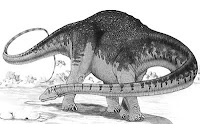1. Seismosaurus, dinosaurs and weighs heaviest and largest.
 Actually, this dinosaur fossils were never found intact and mostly fragmentary. Scientists also make an estimate of the size of this dinosaur and concluded, Seismosaurus can reach lengths of 50 m more! Its own weight is estimated at 100 tons, or the equivalent weight of 20 elephants. That's why he was named Seismosaurus (thunder lizard)
Actually, this dinosaur fossils were never found intact and mostly fragmentary. Scientists also make an estimate of the size of this dinosaur and concluded, Seismosaurus can reach lengths of 50 m more! Its own weight is estimated at 100 tons, or the equivalent weight of 20 elephants. That's why he was named Seismosaurus (thunder lizard)2. Spinosaurus, the largest meat-eating dinosaurs on land.
 Dinosaurs berahang large has 14 m long and weighing 7 tons more. The amount exceeds even Tyranosaurus Rex and Giganotosaurus! Temgkoraknya has a length of up to 1.5 meters. Spinosaurus commonly found in North Africa, especially areas of Egypt. Since World War 2, many Spinosaurus bones were stored in Egypt destroyed by the onslaught of bombers.
Dinosaurs berahang large has 14 m long and weighing 7 tons more. The amount exceeds even Tyranosaurus Rex and Giganotosaurus! Temgkoraknya has a length of up to 1.5 meters. Spinosaurus commonly found in North Africa, especially areas of Egypt. Since World War 2, many Spinosaurus bones were stored in Egypt destroyed by the onslaught of bombers.3. Therizinosaurus, the largest dinosaur with claws.
 Therizinosaurus name meaning "scythe lizard". The name was given because of the long and curved claws like a giant scythe. The length itself is not covered claw meat reaches 90 cm (overall 1.5 m). At first experts thought that this dinosaur is a meat-eating dinosaurs, because they only found the fossils in Mongolia arm. Later, scientists found fossils of intact tooth structure & shocked because nothing like a meat-eating dinosaurs. The experts also think the claws are only used to break a twig or defend themselves from predators.
Therizinosaurus name meaning "scythe lizard". The name was given because of the long and curved claws like a giant scythe. The length itself is not covered claw meat reaches 90 cm (overall 1.5 m). At first experts thought that this dinosaur is a meat-eating dinosaurs, because they only found the fossils in Mongolia arm. Later, scientists found fossils of intact tooth structure & shocked because nothing like a meat-eating dinosaurs. The experts also think the claws are only used to break a twig or defend themselves from predators.4. Brachiosaurus, dinosaurs were the highest.
One of the most famous long-necked dinosaurs, one of them because she is one of a complete dinosaur skeleton was found. Brachiosaurus dinosaur was not the biggest or longest, but he is the tallest dinosaur. If the fossil is a vertical measure, found that the height reached 14 m, while the length of "only" 22 m. Just a note, Seismosaurus, the largest dinosaurs, tall if measured only half of the Brachiosaurus.
5. Oviraptor, the largest egg-eating dinosaurs.
Oviraptor has a unique mouth. His mouth is toothless, but has a half skull very hard. The experts think hard part is used to crush the egg shells and eat the contents. This is reinforced because the fossil was found in the collection of nests of other dinosaurs, Protoceratops. That's why he was named Oviraptor, which also means 'egg thief'
6. Predator X, the biggest water dinosaur once the largest meat-eating dinosaur.
Predator X tentative name for a prehistoric sea predator, which estimated the scientists including Pliosaurus familia. This animal is claimed by the researchers as "the most terrible animal that ever swam in the ocean." This being the length of 15 m, and weighs 45 tons, and had teeth 30 cm. The jaws of this creature might be able to exert greater force than property Tyrannosaurus Rex. Yet these creatures jaw strength estimates vary, with one news source stating bite 10 times more powerful than any modern animals, and four times more powerful than a Tyrannosaurus. This predator skull unearthed in mid-2008 on Svalbard, near the Arctic Ocean, the Norwegian team. The skull is expected to include new species Pliosaurus.
7. Quetzalcoatlus, the largest flying dinosaurs.
Most of the flying dinosaurs (and other flying creatures) do not have a large size, because large size means the body weight & it difficult for them lifted his body in the air. Quetzalcoatlus, flying dinosaur from Mexico are the exceptions. The length of one of its wings to reach 12 m (2 wings mean total length 24 m). If its wings outstretched, this dinosaur could be larger than T-Rex though! The size is large which makes experts confusion, how animals fly? The experts who make a picture of this dinosaur was argued, this animal weighs only about 80 kg due to hollow bones, very lightweight for the size of it. There are 2 estimates by experts how these animals flew off. First, run it first as did the sea gull & aircraft today. Second, jump off a cliff and fly like the giant eagle.
8. Hypselosaurus, the largest dinosaur eggs.
Although most giant-sized, their eggs are not really huge. The biggest dinosaur egg size is approximately the same with ostrich eggs, and dinosaur with eggs by it (which was known until now) is Hypselosaurus, a kind of long-necked dinosaurs. According to experts, the main cause why dinosaurs did not have eggs that really big is the problem of security. The bigger the eggs, meaning the thick shell. However, the thick shell would be difficult for babies to hatch. When the shell is thin, the risk of rupture prior to hatch into large because of the risk of depressed yolk movement from within.





